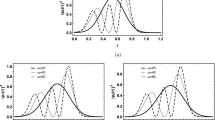Abstract
One of the characteristic features of rotation–vibration dynamics is the existence of a variety of energy bands which result from organization of energy levels into bands depending on control parameters. Symmetry and topology aspects of the organization of energy bands and generic modifications of this structure for molecular systems with symmetry are discussed in a way parallel to the description of topological quantum transitions extensively studied in condensed matter physics. A special class of axially symmetric molecular systems is analyzed. It is shown that only a finite number of different band structures are possible for rotation–vibration problem with a finite number of vibrational states in the case of continuous axial symmetry, whereas for problems with finite group symmetry an arbitrary large number of different band structures are formally allowed.







Similar content being viewed by others
Notes
The number of one-dimensional representations of a group is equal to the order of Abelianization, i.e., the order of the Abelian group \(G/[G,G],\) the quotient of \(G\) by the commutator \([G,G].\)
References
Arnold VI (1995) Remarks on eigenvalues and eigenvectors of Hermitian matrices, Berry phase, adiabatic connections and quantum Hall effect. Selecta Mathematica 1:1–19
Berry MV (1984) Quantal phase factor accompanying adiabatic changes. Proc R Soc Lond A 392:45–57
Brodersen S, Zhilinskii B (1995) Transfer of clusters between the vibrational components of CF4. J Mol Spectrosc 169:1–17
Broer HW, Cushman RH, Fassò F, Takens F (2007) Geometry of KAM-tori for nearly integrable Hamiltonian systems. Ergod Theory Dyn Syst 27:725–741
Caspers WJ (2008) Degeneracy of the eigenvalues of hermitian matrices. J Phys Conf Ser 104:012032
Chen X, Gu Z-C, Liu Z-X, Wen X-G (2012) Symmetry protected topological orders and the group cohomology of their symmetry group. Science 338:1604–1606
Cushman RH, Duistermaat JJ (1988) The quantum mechanical spherical pendulum. Bull Am Math Soc 19:475–479
Efstathiou K, Sadovskii D (2010) Normalization and global analysis of perturbations of the hydrogen atom. Rev Mod Phys 82:2099–2154
Faure F, Zhilinskii B (2000) Topological Chern indices in molecular spectra. Phys Rev Lett 85:960–963
Faure F, Zhilinskii B (2002) Topologically coupled energy bands in molecules. Phys Lett A 302:242–252
Shapere A, Wilczek F (eds) (1989) Geometric phases in physics. World Scientific, Singapore
Faddeev LD, Popov VN (1967) Feynman diagrams for the Yang–Mills field. Phys Lett B 25:29–30
Harter W (1993) Principles of symmetry, dynamics, and spectroscopy. Wiley Interscience, New York
Hasan MZ, Kane CL (2010) Topological insulators. Rev Mod Phys 82:3045–3067
Iwai T, Zhilinskii B (2011) Energy bands: Chern numbers and symmetry. Ann Phys (NY) 326:3013–3066
Iwai T, Zhilinskii B (2012) Rearrangement of energy bands: Chern numbers in the presence of cubic symmetry. Acta Appl Math 120:153–175
Iwai T, Zhilinskii B (2013) Qualitative features of the rearrangement of molecular energy spectra from a “wall-crossing” perspective. Phys Lett A 377:2481–2486
Iwai T, Zhilinskii B (2014) Chern number modification in crossing the boundary between different band structures. Three band model with cubic symmetry. Submitted for publication
Kane CL, Mele EJ (2005) Z 2 topological order and the quantum spin Hall effect. Phys Rev Lett 95:146802
Kitaev A (2009) Periodic table for topological insulators and superconductors. AIP Conf Proc 1134:22–30
Kohmoto M (1985) Topological invariant and the quantization of the Hall conductance. Ann Phys (NY) 160:343–354
Kontsevich M, Soibelman Y (2013) Wall-crossing structures in Donaldson–Thomas invariants, integrable systems and mirror symmetry. arXiv:1303.3253 to appear in Lecture Notes in Mathematics
Michel L, Zhilinskii B (2001) Symmetry, invariants topology. Basic tools. Phys Rep 341:11–84
Moore JE, Balents L (2007) Topological invariants of time-reversal-invariant band structures. Phys Rev B 75:121306(R)
Pavlichenkov I, Zhilinskii B (1988) Critical phenomena in rotational spectra. Ann Phys (NY) 184:1–32
Pavlov-Verevkin VB, Sadovskii DA, Zhilinskii BI (1988) On the dynamical meaning of diabolic points. Europhys Lett 6:573–78
Sadovskii D, Zhilinskii B (1999) Monodromy, diabolic points, and angular momentum coupling. Phys Lett A 256:235–44
Sadovskii D, Zhilinskii B (2006) Quantum monodromy, its generalizations and molecular manifestations. Mol Phys 104:2595–2615
Shrivastava KN (2004) Negative-spin quasiparticles in quantum Hall effect. Phys Lett A 326:469–472
van Tonder A (2002) Ghost as negative spinors. Nucl Phys B 645:371–386
Vu Ngoc S (1999) Quantum monodromy in integrable systems. Commun Math Phys 203:465–479
Zhilinskii B (2001) Symmetry, invariants and topology in molecular models. Phys Rep 341:85–172
Zhilinskii B (2011) Quantum bifurcations. In: Meyers R (ed) Mathematics of complexity and dynamical systems. Springer, New York, pp 1438–1456
Zhilinskii B, Brodersen S (1994) The symmetry of the vibrational components in T d molecules. J Mol Spectrosc 163:326–338
Author information
Authors and Affiliations
Corresponding author
Additional information
Dedicated to Professor Greg Ezra and published as part of the special collection of articles celebrating his 60th birthday.
Rights and permissions
About this article
Cite this article
Iwai, T., Zhilinskii, B. Topological phase transitions in the vibration–rotation dynamics of an isolated molecule. Theor Chem Acc 133, 1501 (2014). https://doi.org/10.1007/s00214-014-1501-x
Received:
Accepted:
Published:
DOI: https://doi.org/10.1007/s00214-014-1501-x




